Although traditional body-on-frame sports utility vehicles (SUV) have definitely lost the edge they had in previous decades, modern-day crossovers are still unable to replace them properly. By that, I mean modern SUV/Crossovers don’t possess the level of off-road capability, towing, and durability their more rugged predecessors did. Then again, they were built like that on purpose. Classic SUVs are nearly impossible to replicate and meet modern safety, emissions, and comfort standards.
Most people agree that modern SUV inspiration came from WWII military Jeeps and Land Rovers. While this idea is right in principle, these certainly weren’t the world’s first 4×4 off-road capable vehicles with a large enclosed interior cargo area. Extremely low production Soviet-built 4×4 GAZ-61 first made back in 1938, on the other hand, is one of them.

The Best Classic 4×4 SUVs
A gap of more than seven decades spans the production time frame of classic 4×4 SUV on our list, the post-war years. These 4×4 classic SUVs are listed in no specific order. There are a few things you should know about the selection process, however. To make the selection fair, only production vehicles were eligible. No custom, off-road racing specials here.
Which of these classic SUVs would you choose for that coveted empty garage spot of yours? We couldn’t possibly hold your hand on this one, as we were faced with the same dilemma. It was simply impossible to pick “the one” in a sea of gems. This is why we’ve picked no less than 10, and believe me, it was still hard to narrow it to this list.
1961-1971 Land Rover Series IIA

The Series IIA Land Rover is considered by many to be the most rugged and dependable Landy ever made. That alone earns it the spot among the best 4×4 classic SUVs ever made. But one of the most recognizable Landy’s has much more to offer than that. The ultimate safari machine set a record as best-sold Land Rover vehicle ever for 1970 model year when close to 60,000 of them found a new home after rolling out of the Solihull England plant’s doors.
Series IIA didn’t differ that much from its ’58-’61 Series II predecessor. Apart from some minor cosmetic changes, the only real difference came in the new 2.25L diesel four-cylinder which equalized displacement figures between Land Rover diesel and petrol engines. The 2.25L petrol four-cylinder was already standard since series II, and would remain in use until 1985. It delivered 74 horsepower and 120 lb.-ft. of torque, with thanks to a Solex carburetor. The diesel mill, on the other hand, yielded only 62 ponies and 103 lb.-ft. of torque. The emphasis was on efficiency, however. Besides fuel efficiency the diesel also saved Land Rover a ton of money, as it shared the same block, cooling system, and valve gear (among other parts) as its petrol sibling.
Not only was Series IIA one of the best classic SUVs ever made, but it was also quite popular as well. Australian, numerous African and Middle Eastern 4×4 markets consisted primarily of Landy’s during the sixties. Of Landy’s and pretty much nothing else, since more than 90% of four-wheel-drive SUVs there were Land Rovers.
1960-1984 Toyota Land Cruiser FJ-40
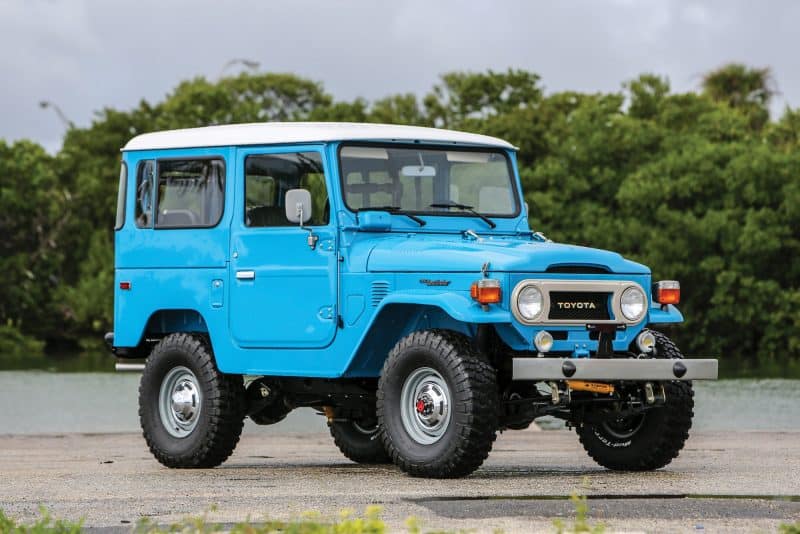
Early Toyota Land Cruiser are another vintage 4×4 icon that has undoubtedly defined the whole classic SUVs era. Toyota’s longest-running nameplate got introduced in 1951, but it wasn’t until 1960 and the J40 Series that it finally received the recognition it deserved. Recognized as being one of the sturdiest and most reliable SUVs ever made. In fact, Land Cruiser’s reputation would pass onto other Toyota vehicles, namely Hilux pickups, which are still being marketed under the “indestructible” moniker.
The only downside to early Land Cruisers was its somewhat anemic engine options. The J40 Series and its B-engines generated between 80 and 100 horsepower. This is where FJ-40 Series’ F engines came in handy. A 3.9L inline-six delivered either 105 hp or 125 hp and 189 lb.-ft. or 209 lb.-ft. of torque. Updated F. 5 mill that ran between ’73 and ’74 received a new oil system which would later get carried over into F engine’s successor, the 2F. New 2F mills, introduced the following year, came with 4.2L displacement and an increase in power. They now delivered 135 hp and 210 lb.-ft. of torque, and would motivate all FJ Land Cruisers until 1988. Even these figures, however, didn’t exactly bring down the house as Land Cruisers remained largely underpowered for their size and weight until J70 models debuted in early 1984.
For all its lack of power, FJ-40 compensated with highly durable and reliable powertrains, and extremely durable body and frame. Massive axles and bearings, and thick hot-riveted frame made this particular SUV capable of withstanding immense amounts of punishment without breaking down. Plus, if you don’t like its dreadful power to weight ratio, there’s always a V8 engine swap you can undertake.
1960-1980 International Harvester Scout
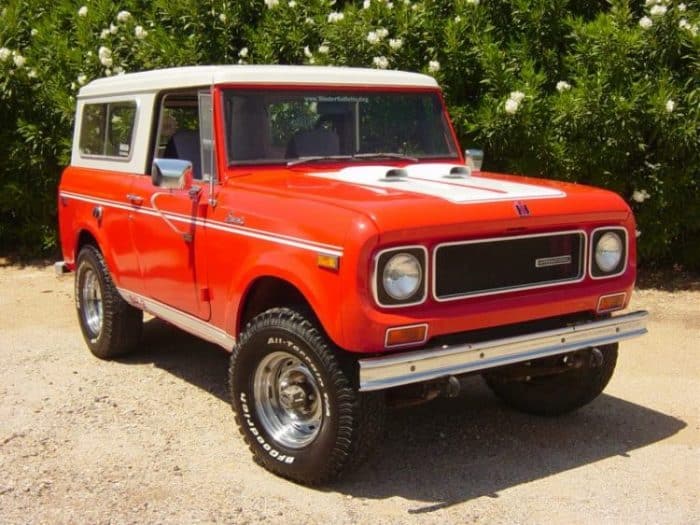
At the time when International Harvester Scout was conceived, American-made off-road 4×4 recreational vehicles were limited to the CJ-5. And, that’s it. It’s interesting that International Harvester designers had, at first tried to copy Kaiser-Jeep’s flatfender spartan mini, but they failed to light the spark among their superiors. When the project started dying on the vine, chief designer Ted Ornas came with a much softer contour sketch that would finally get the much-needed break. Scout would finally get approved in November 1959, while the first models would roll off the assembly lines the following year. All in all, the complete Scout development process only took 24-months to complete.
The original Scout 80 ran from 1960 to 1965. Early models came with a fold-down windshield and sliding side windows – a feat we don’t see that often these days. A 152ci Comanche in-line four with 92 horsepower remained the only available engine throughout the period. Scout 800, 800A and 800B (available for only 8 months) which replaced it, were more comfortable and came with optional 4-cylinder, inline-six, and even 266ci and 304ci V8s. The latter of which developed as much as 193 hp and 272 lb.-ft. of torque.
It wasn’t until International Scout II years (1971-1980) that the compact SUV had reached its peak. Its 345ci V8 mill at first developed 195 hp and 309 lb.-ft. of torque. As early as of 1973, however, it only managed 144 horsepower and 285 lb.-ft. of torque thanks to lowered compression ratios and catalytic converters. Even Nissan‘s diesel engines were available in the Scout II between 1976 and 1980.
Still, 4×4 International Scouts were praised for their durability and off-roading capability. At least models with optional heavy-duty Dana 44 differential and Dana 20 transfer case were. Moreover, 4-cylinder Scout was easy enough on its drivetrain due to its anemic power ratings. Only rust was able to gain the upper hand on these spacious, yet compact classic SUVs.
1954-1983 Jeep CJ-5
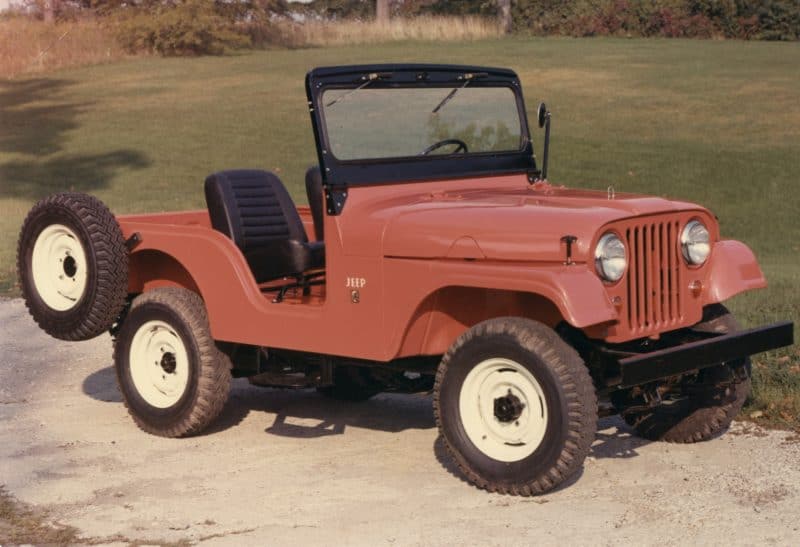
Flatfender Jeeps are rightfully considered the grandfathers of recreational off-roading. Among them, CJ-5 stands out as the most popular, one of the most capable, and most reliable 4×4 SUVs ever devised by humankind. And rightfully so. It’s no wonder Jeep CJ-5 remained virtually unchanged for almost three full decades. In fact, Jeep’s corporate ownership changed hands much sooner than CJ-5 got phased out.
It took almost a full decade before Willys-Overland perfected civilian Jeep’s production process. By the time CJ-5 was introduced in 1954, however, the company was bought by Henry J. Kaiser and renamed Kaiser-Jeep in accordance. CJ-5 would, however, live to see another takeover – one in which AMC completely took over the company and renamed it Jeep Corporation.
The 134ci Willys Hurricane in-line four served as CJ-5’s backbone engine until 1971. In the meantime, CJ-5 could have been had with options like 192ci Perkins diesel I4 and Buick’s 225ci Dauntless V6. The AMC years saw the Hurricane engine phased out and the introduction of new, stronger in-house engines. 232ci and 258ci AMC straight-sixes and a top of the line 305ci V8 raised the bar considerably. This, in turn, helped CJ-5 become much more than a capable compact rock crawler. It was now more of a rock glider.
Even though the Iron Duke 4-cylinder engine was standard equipment between 1980 and 1983, it didn’t manage to kill off CJ-5. What ultimately lead to its demise, were the SUVs sub-par safety scores. At least, that’s how the general population was lead to believe back then. IIHS practically set CJ-5 up by generating the worst-case scenario conditions while testing it. It was all disclosed in one controversial “60 Minutes” report during December 1980, and people bought it. To be fair, Jeep CJ-5 was 30 years old by then, and it never was intended as safety equipment packed vehicle. Then again, it certainly wasn’t as bad as IIHS portrayed it to be.
1977-Present Lada Niva
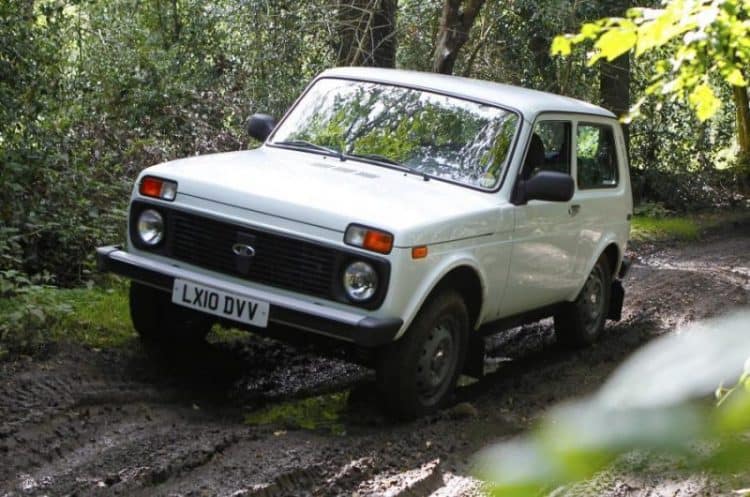
One can dispute Lada Niva’s appearance on this list all he likes, but no one can dispute the tiny Soviet SUV’s off-road capability. So, what are exactly Niva’s shortcomings compared to other classic SUVs here? To begin with, it was never imported into the US, although it was both produced and marketed around the world. Then, Niva is far from body-on-frame SUVs of old. In fact, if you’re looking for a culprit responsible for modern-day crossovers, look no further. Lada Niva is the world’s first mass-produced unibody SUV with independent coil spring front suspension. A definition of most modern crossovers indeed.
In true Soviet fashion, Lada Niva only offered two engine choices over the span of 40 years (and counting). Furthermore, it didn’t exactly evolve in terms of design either. Some would say it was perfect from the beginning, but we know Eastern Bloc car philosophy better than that. The above mentioned dynamic duo of 4-cylinders consisted of a 1.6L and 1.7L. The former was a 72-horsepower carbureted one, while the latter arrived in 1993 and brought GM’s single-point fuel injection with it. Some markets offered Peugeot’s 1.9L diesel as well, but they’re much rarer than original Russian petrol engines.
As spartan as anything car-related coming out of Russia, Lada Niva can traverse any given terrain. There’s truly no place one of the best off-road SUVs can’t tame. 4WD and rugged nature go a long way, but Niva’s compact size and low weight complement the former couple of attributes rather well. The complete package is a nicely rounded amalgam of immense off-road capability, fine maneuverability, convenience features list consisting of an ashtray (that’s all folks), and a back-breaking stiff ride.
All in all, Lada Niva is, hands down, one of (if not the) the best Eastern Bloc vehicles ever made. Oh, and before I forget, there’s also a modern interpretation of Niva donning the Chevrolet badge. Sadly, these too, are only available in Russia.
1997-2006 Jeep Wrangler TJ
![]()
Although not usually perceived as capable as its distant predecessor the CJ, Wrangler still plays an important role in four-wheel drive off-roading history. Over the years, Jeeps traded part of their off-road capabilities for amenities like comfort and safety. That doesn’t mean they’ve completely lost the touch, though. Furthermore, Jeep Wrangler TJ can be credited for bringing the off-roading capability to many more people than its predecessors. A feat that its successor JK only built upon. Finally, it was the Jeep TJ that introduced nameplates like Rubicon and Unlimited, which are considered vital parts of the modern Jeep lineup.
Being introduced in the mid-nineties, Jeep Wrangler TJ kept some of the AMC heritage. Namely their engines. Throughout their run, the strongest Jeep TJ’s were powered by 242ci straight-six engine mated to 3 or 4-speed automatics, or 5 or 6-speed manuals. The standard engine up until 2002 was AMC’s 150ci in-line four with slightly more than 100 horsepower. It was superseded by contemporary 150-horsepower 2.4L in-line four used in PT Cruiser (naturally aspirated form) and Dodge Neon (turbocharged form).
Aside from rare and one year only packages, most capable off-road Jeep TJ’s were those hiding under the Sport badge. Sport trim level included the strongest available 4.0L straight-six engine and Dana 35 rear axle. Even better, they offered optional Dana 44 rear axle, 3.73 axle ratio, and 30-inch tires that could traverse most terrains with ease. In 2002, Jeep introduced the Rubicon trim which sported standard Dana 44 front and rear axles and became one of the most capable off-roading Jeeps ever produced. Long-wheelbase Unlimited models would debut in 2004, while ultimate Unlimited Rubicon Jeep TJ’s arrived a few months later.
1969-1972 Chevrolet Blazer K5
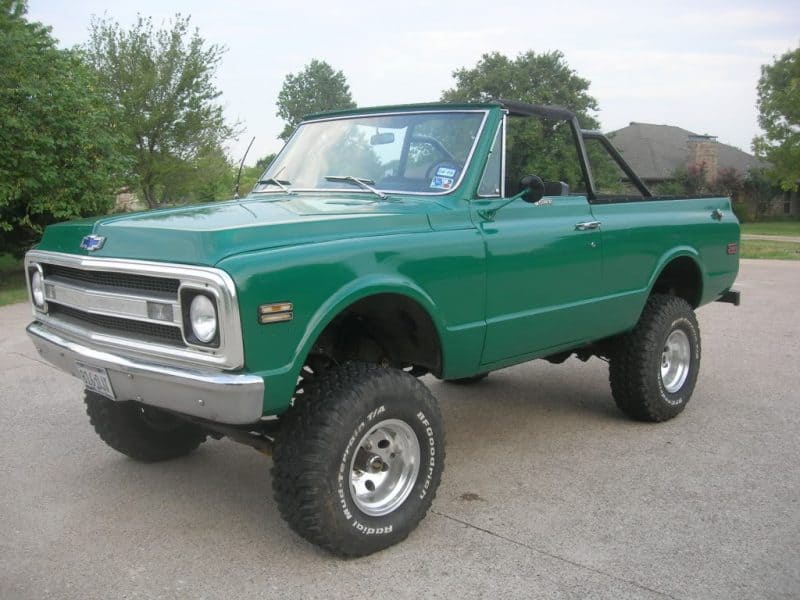
When the K5 Blazer got introduced in 1969, the International Scout and Ford Bronco fighter came with mandatory 4WD. Later models would get to choose between 2WD and 4WD, but the aforementioned fact speaks a lot about Blazer’s intended nature. The most compact of all full-size Chevrolet pickup-based SUVs was designed with 4×4 off-road capability in mind. But the biggest advantage classic SUV held over its rivals was more upscale amenities like air conditioning that came from the Blazer’s pickup truck roots. Plus, Chevy was able to keep its prices low due to platform sharing.
First-generation Chevy Blazer came with three different engine options. The smallest of the lot was the 250ci straight-six, while the larger two were V8’s (307ci and 350ci). Needless to say, Chevrolet’s highly popular 350ci V8 with 200 SAE net horsepower (255 hp gross) was the most popular option. These figures would drop to 175 hp by 1972, however. A Turbo Hydromatic 3-speed automatic was one way to go, but 4-speed manual trans stood as a prerequisite for the optional Dana 20 transfer case unavailable otherwise.
This pioneer of pickup-based SUVs could have been ordered either with a fiberglass hardtop or a vinyl soft top, which made it competitive in a segment where all of its opponents had something similar to offer. But, half-ton the Blazer was much different than its competitors. As sales figures would later suggest, it was also more appealing to average American buyers. Although its robust vitals somewhat hampered Blazer’s off-road capability, the pickup-derived 4×4 SUV was still one of the best trail-prepped vehicles available back then.
1984-1989 Toyota 4Runner N60

Toyota entered the short-bed pickup bodied SUV segment a bit later than its main competitors. That didn’t interfere with their decision to implement the same system as Chevy Blazer and second-gen Ford Bronco, however. Toyota, too, took its pickup truck and converted it into SUV by reworking the rear half. Since the truck in question was the indestructible Hilux (the same Hilux, Top Gear trio unsuccessfully tried to destroy during one of their more inspiring moments). It’s evident why 4Runner stands shoulder to shoulder with the best of them!
Most first-gen 4Runners were offered with 2.4L in-line four-cylinder engine and 5-speed manual transmission. The one-hundred horsepower that this carbureted system raised went up by 16 ponies when electronic fuel injection became available in 1985. Other than that, Toyota also offered an optional turbocharged version of the 2.4L mill tied to a 4-speed auto, for 1986 and 1987. This engine was replaced with another optional mill, a 3.0L V6, this time.
Apart from offering the highest amount of ground clearance among small SUVs in the US market back then, the first two model years sported removable fiberglass rear section and a solid front axle. Later models introduced independent front suspension, arguably decreasing 4Runner’s off-road capabilities going forward. Rear leaf spring suspension continued throughout 4Runner’s first-generation run. Although modern-day IFS underpins almost every serious dirt machine, most capable off-roading 4×4 4Runners were those with solid front suspension. The SR5 trim with upgraded interior and a standard rear bench seat in particular.
1985-1995 Suzuki Samurai

The Suzuki Samurai (originally named Jimny overseas) was neither best nor most capable off-road 4×4 SUV. But, I dare you to find any affordable compact off-roader as fun and readily available as the Samurai. This fun and easy-going compact is arguably the best entry-level off-roading option money can buy.
Original Jimny’s continuous ascend dates back to 1970 after Suzuki acquired another Japanese automaker – Hope Motor Company. The American market was penetrated in 1985 and the petite Suzuki became an instant hit. 63-horsepower 1.3L 4-cylinder available from the get-go would be updated in 1990. The new 1.3L 4-cylinder with throttle-body fuel injection, however, wasn’t all that different. It only added meager 3 horsepower to the final output.
The Samurai’s success lies in its low weight convertible top body (hardtop wasn’t nearly as popular and got axed in 1989) and readily available 4WD with a transfer case. In 1988 the Samurai received an upgraded suspension, larger anti-roll bar, and lower fifth gear, which made them even more of a threat to their respective competitors.
All that was flushed down the drain by Consumer Reports magazine, which labeled the Suzuki Samurai prone to rollover. In a similar fashion which IIHS had used to discredit Jeep CJ-5, Consumer Reports only took sudden swerve test into consideration. Needless to say, Suzuki Samurai was as safe as any other vehicle in normal driving conditions, but the damage was done. Sales would soon start to dwindle and the American market would lose one of the last true compact 4×4 SUVs. Luckily, the Suzuki Jimny is still going strong across the seas.
1966-1977 Ford Bronco
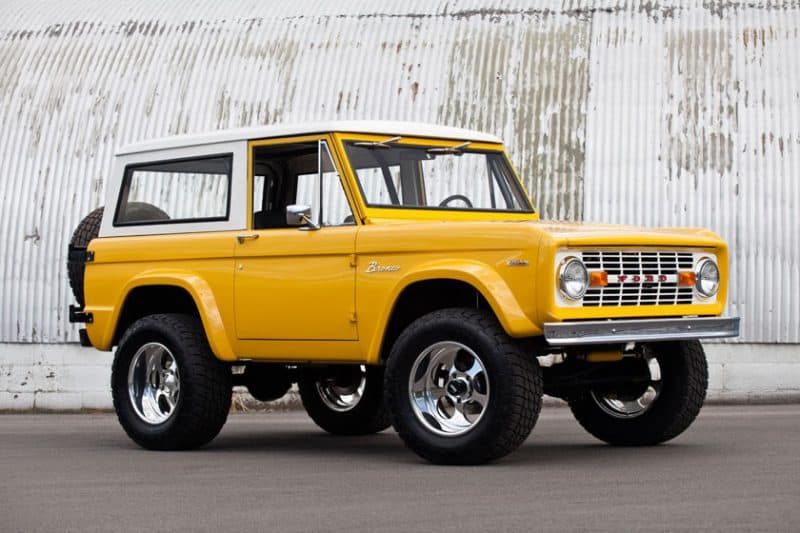
The Ford Bronco is undoubtedly one of the most beloved American classic SUVs, but that’s just the tip of the iceberg. It’s also one of the most capable of all off-roading classic SUVs ever created. Especially early, more compact models. Unlike proven off-road rigs like Jeep CJ-5, Land Rover and Toyota Land Cruiser, Ford Bronco offered something more. Something that mentioned trio didn’t have back then. You guessed it, V8 power.
Bronco offered a duo of Windsor V8 engines even before it grew in size. The first offered V8 came in 1967, a 289ci Windsor that developed 200 horsepower. But Chevy Blazer’s introduction in ’69 forced the Blue Oval into boosting Bronco’s ratings. That’s why they introduced the 302ci Windsor with 205 ponies that year. However, the 4.9L Windsor was still some 50 horsepower short compared to Blazer’s famous 350ci small-block. The original Bronco engine from 1966 until 1973 was a 170ci straight-six which later got replaced by 200ci straight-six.
As an off-road rig, Bronco also featured a 9-inch rear end, Dana 30 front axle, and F-100’s brakes. In 1971, the Dana 30 front axle got replaced by heavier Dana 44 front, while disc brakes became standard during first-gen Bronco’s last year. They were, however, available as optional equipment a year before.
Early Broncos were perfectly executed. They were reliable and capable off-roaders with more space than their Jeep coevals, yet compact enough not to get stuck in tight spots. As mentioned before, one of the biggest advantages they boasted over their opponents was that optional V8 power. No need to mention their customization ability. The ability that was proven time and again. Just look at the likes of ’69 Stroppe-prepped and Baja Broncos, former of which was the first four-wheel-drive vehicle ever to win the Baja 1000 overall.
The 2021 Ford Bronco harkens back to its roots but doesn’t come with a V8, yet anyway.
